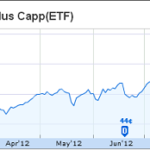In an era of an ETF or mutual fund for every idea or investment theme one can conjure up, one such fund focusing on capitalizing on uncertain market direction is the Collar Fund (symbol COLLX). For those unfamiliar with the options collar strategy, it is a case where one simultaneously buys a put option and sells a call option on an underlying asset (typically to match 1 options contract on either side with 100 shares of the underlying equity. The theory is that while you may forgo some massive upside gain once the shares have breached the call strike price, you will have at least realized that nominal gain up to that point; meantime, you can limit your downside with that protective put option.
Personally, I’ve used collars before, but not for a long term investment strategy. I like collars for a situation where you’re sitting on a sizable taxable gain on a position and you want to protect those gains, but want to push that taxable gain into next year. You could do the collar for January expiry with a net zero cash outlay, protect your range, and push a sizable gain out into the next tax year. The difference here is that the fund isn’t focused on tax efficiency, but just providing more muted returns while minimizing losses in various market conditions.
Holdings:
The Collar Fund’s most recent update showed top holdings in companies like Research in Motion (RIMM), Baidu.com (BIDU), Apple (AAPL) and a mix of industrials, materials, and other sectors.
Collar Fund Performance:
The fund would be expected to limit losses (and hence outperform broad market indices) in a down market, but would also be expected to under-perform in an up market. Since its launch in 2009, there have been spurts of each, so let’s take a look under the hood during some periods of each vs. the S&P500 (SPY):
Since Inception: Loser
Going back to July 17, 2009, COLLX gained 4% while SPY gained 22%
Market Upswing: Loser
During an up market from July 17, 2009 to Jan 8, 2010 when SPY gained 30%, COLLX gained only 7%.
Down Market: Winner (sort of)
During a down leg from Jan 8, 2009 through July 7, 2010 when SPY lost 7%, COLLX lost only 2%. To call this fund a winner is a bit of a misnomer though. Do you really want to bank on going long in a down market? Or perhaps just sit it out altogether if that’s the environment you anticipate?
Flat Market: Wash
In looking for a longer duration flat market, from Oct. 26, 2009 through Aug. 19, 2010, with SPY flat at -.2%, COLLX gained 0.39%. Given the higher expense ratio of 0.99%, overall, it’s about a wash or possibly even a loser, depending on how long you ultimately hold the fund.
This really begs the question as to where you see the market headed and whether you should be in this fund at all, subjecting yourself to fees, transaction costs, tax liabilities and a lack of liquidity.
- If you think the market’s going up, why would you want to limit your gains with a fund like this?
- If you think the market’s going to decline, why would you be in equities at all? Cash, corporate bonds, or even inverse funds would be your play.
- If you think the market’s going to be flat, you could also derive positive gains from high yield investments such as high dividend ETFs , this new Master Limited Partnership ETF , Utility Stocks and you’d also want to check this list of REITs if you think we’re not on the brink of a commercial real estate collapse.
Disclosure: The author has no holding in COLLX and owns puts on SPY as hedge; see full portfolio holdings here.











{ 0 comments… add one now }